Strange Vehicles > Polar Snow Crawler PSC-001
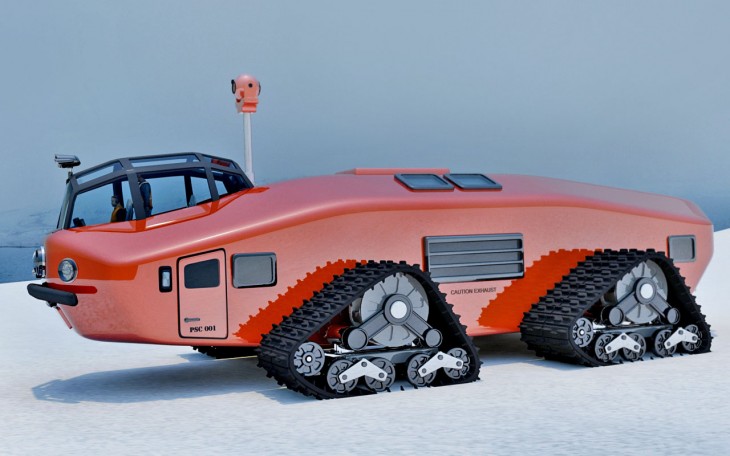
It might not look like it, but this futuristic-looking giant was actually inspired by the one-of-a-kind Antarctic Snow Cruiser which was constructed way back in the 1930s. The original vehicle was designed by arctic explorer Thomas Poulter and used in an antarctic expedition commanded by Rear Admiral Richard Byrd, Jr. It proved to be a massive failure, primarily because its slick tires were almost completely useless on the slippery snow and ice.
Poulter never got the chance to make changes to his creation to make it more suitable for polar exploration. He wanted to, and even drew up plans, but something called the Second World War prevented him getting the funds and support from the US government to do so. Now, 73 years after the original vehicle was abandoned in the Antarctic, we've put together a 21st century snow-conquering leviathan inspired by Poulter's visionary Antarctic Snow Cruiser.
Called the Polar Snow Crawler PSC-001, the vehicle is of a similar size to the original. However in place of wheels are more snow-orientated rubber tracks. The PSC-001 carries all the supplies and equipment for research scientists working in the world's polar regions. It has sleeping space onboard, kitchen facilities, a small washroom, and plenty of space for supplies, spares and equipment as well as research stations and labs.
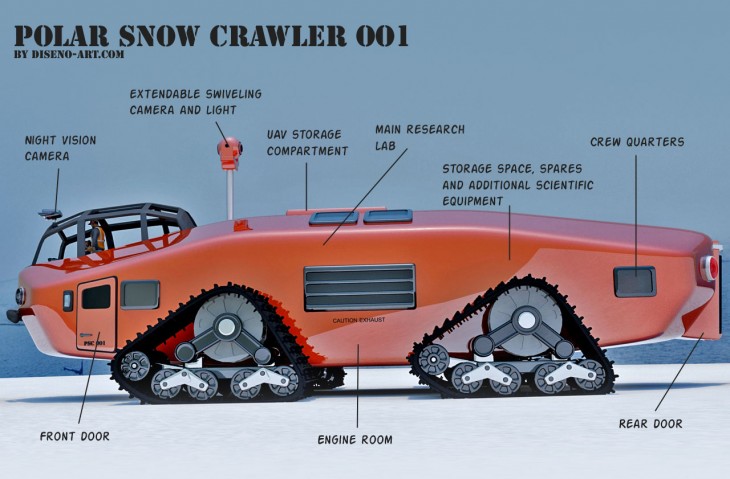
For longer missions, or when required, the Polar Snow Crawler can also tow equally massive trailers across the snow, a bit like the Alaskan Land Train used to back in the '50s. These trailers could carry heavy-duty ice boring equipment for taking core samples from deep underground, additional housing units, meteorological stations, or other research modules.
Inside the PSC-001 the crew are offered a comfortable but practical environment. The cockpit has seating for two, however there is standing room for more personnel and observers. The vehicle is controlled by a simple joystick located on the right side armrest of the driver's seat. Multi-configuration touchscreen monitors provide the operators with navigation, weather and communications data. The monitors can also relay images from any of the onboard cameras positioned around the vehicle. These offer night vision as well as thermal vision.
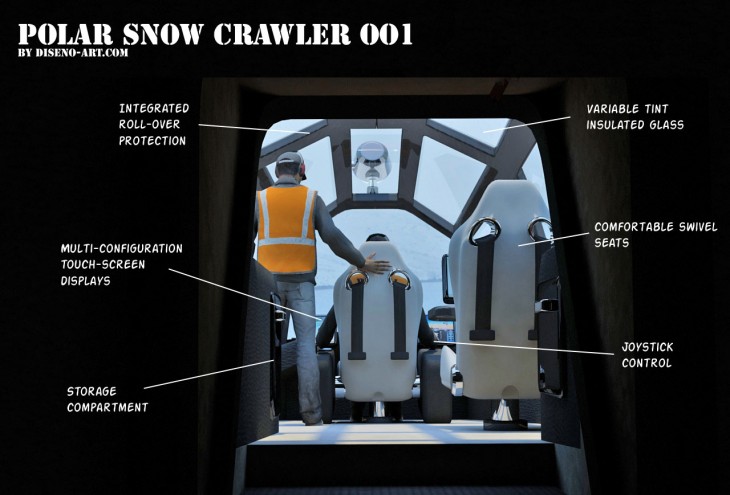
Located behind the cockpit is the main research lab and analysis room, here the scientists can study data and conduct experiments. Underneath this is the engine room where the diesel/electric drivetrain is housed. Behind the research lab and down a couple of steps are the crew quarters. This consists of four private bunks (with room for two temporary bunks if needed), a small shower room and toilet, a kitchen/galley, and storage space.
The ride height of the vehicle can be raised for crossing particularly rough terrain, while the hull is watertight and incorporates foam insulation. Meaning that if it were to go through the ice it would float. Aside from the cockpit there are only a few windows - primarily to conserve heat. The sides are thick and well insulated to keep the interior as warm as possible.
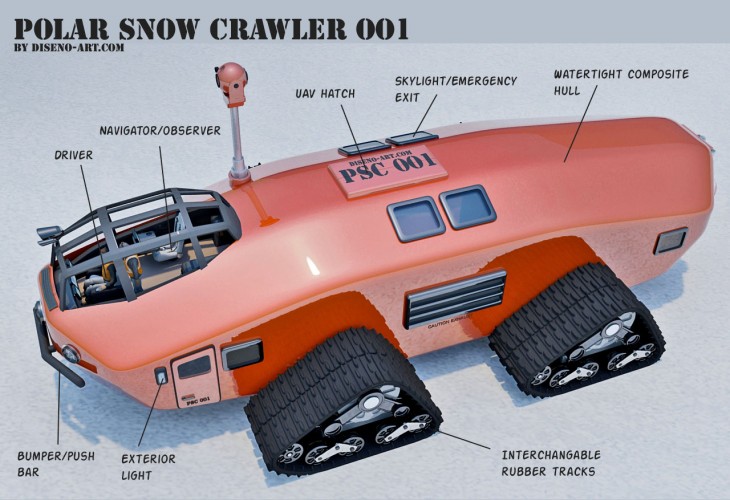
On Poulter's original Antarctic Snow Cruiser, he added a small aircraft to the top which could be deployed for aerial observation. On the PSC-001 an unmanned UAV offers the same capabilities but in a much smaller and more economical package. The UAV can be launched and recovered from the vehicle via a hatch in the roof. It carries a number of cameras for surveying the land ahead and it can relay the images back to any of the monitors inside in real time.
An extending camera pod located behind the cockpit and to the right can be raised to offer a fantastic view of the surrounding land. It carries a powerful high-zoom camera, and a spotlight. It can be rotated through 360 degrees in any direction and can be controlled by the driver or by anyone seated at any of the observer/research stations.
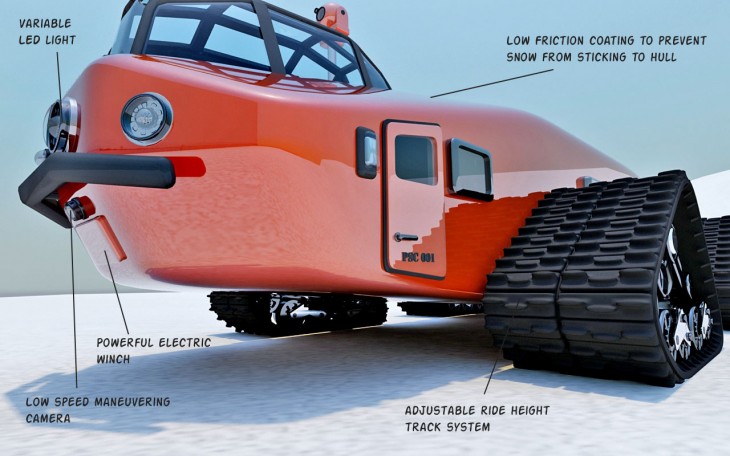
Powering the Polar Snow Crawler PSC-001 is a fuel-efficient diesel/electric hybrid drive system which transfers power to all four tracks. The steering is identical to that of a tank, one side stops or goes into reverse to make turns. This gives the vehicle the ability to turn around its own axis if needed.
Of course this isn't a vehicle destined for production. It's just a look at what could have been, had Thomas Poulter had access to modern technology, materials, systems and computers when he was dreaming up his original Antarctic exploration vehicle. Pictured below are the two of them photographed before the 1939 expedition.
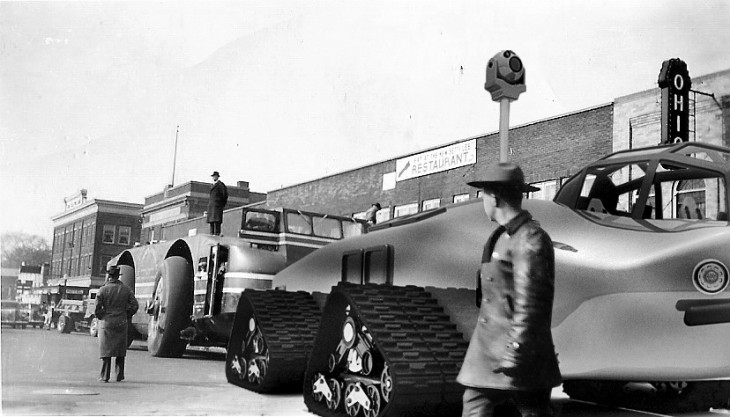
The images in this article may be used for editorial use with a credit to diseno-art.com and/or Jeff Darling.
--
